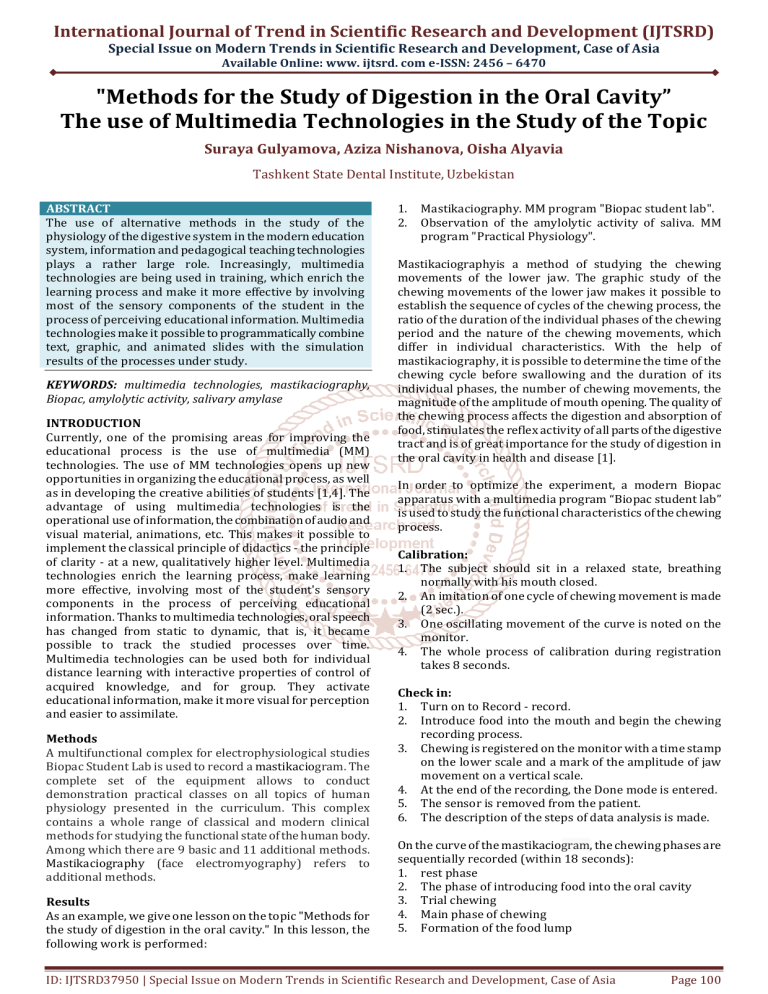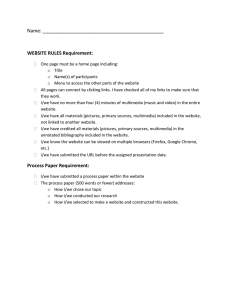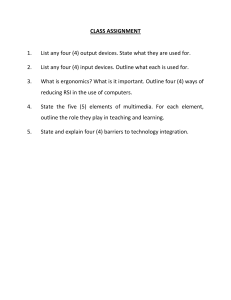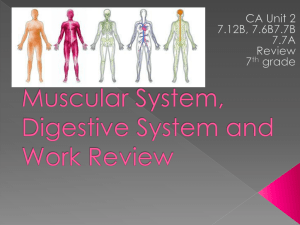
International Journal of Trend in Scientific Research and Development (IJTSRD)
Special Issue on Modern Trends in Scientific Research and Development, Case of Asia
Available Online: www. ijtsrd. com e-ISSN: 2456 – 6470
"Methods for the Study of Digestion in the Oral Cavity”
The use of Multimedia Technologies in the Study of the Topic
Suraya Gulyamova, Aziza Nishanova, Oisha Alyavia
Tashkent State Dental Institute, Uzbekistan
ABSTRACT
The use of alternative methods in the study of the
physiology of the digestive system in the modern education
system, information and pedagogical teaching technologies
plays a rather large role. Increasingly, multimedia
technologies are being used in training, which enrich the
learning process and make it more effective by involving
most of the sensory components of the student in the
process of perceiving educational information. Multimedia
technologies make it possible to programmatically combine
text, graphic, and animated slides with the simulation
results of the processes under study.
KEYWORDS: multimedia technologies, mastikaciography,
Biopac, amylolytic activity, salivary amylase
INTRODUCTION
Currently, one of the promising areas for improving the
educational process is the use of multimedia (MM)
technologies. The use of MM technologies opens up new
opportunities in organizing the educational process, as well
as in developing the creative abilities of students [1,4]. The
advantage of using multimedia technologies is the
operational use of information, the combination of audio and
visual material, animations, etc. This makes it possible to
implement the classical principle of didactics - the principle
of clarity - at a new, qualitatively higher level. Multimedia
technologies enrich the learning process, make learning
more effective, involving most of the student's sensory
components in the process of perceiving educational
information. Thanks to multimedia technologies, oral speech
has changed from static to dynamic, that is, it became
possible to track the studied processes over time.
Multimedia technologies can be used both for individual
distance learning with interactive properties of control of
acquired knowledge, and for group. They activate
educational information, make it more visual for perception
and easier to assimilate.
Methods
A multifunctional complex for electrophysiological studies
Biopac Student Lab is used to record a mastikaciogram. The
complete set of the equipment allows to conduct
demonstration practical classes on all topics of human
physiology presented in the curriculum. This complex
contains a whole range of classical and modern clinical
methods for studying the functional state of the human body.
Among which there are 9 basic and 11 additional methods.
Mastikaciography (face electromyography) refers to
additional methods.
Results
As an example, we give one lesson on the topic "Methods for
the study of digestion in the oral cavity." In this lesson, the
following work is performed:
1.
2.
Mastikaciography. MM program "Biopac student lab".
Observation of the amylolytic activity of saliva. MM
program "Practical Physiology".
Mastikaciographyis a method of studying the chewing
movements of the lower jaw. The graphic study of the
chewing movements of the lower jaw makes it possible to
establish the sequence of cycles of the chewing process, the
ratio of the duration of the individual phases of the chewing
period and the nature of the chewing movements, which
differ in individual characteristics. With the help of
mastikaciography, it is possible to determine the time of the
chewing cycle before swallowing and the duration of its
individual phases, the number of chewing movements, the
magnitude of the amplitude of mouth opening. The quality of
the chewing process affects the digestion and absorption of
food, stimulates the reflex activity of all parts of the digestive
tract and is of great importance for the study of digestion in
the oral cavity in health and disease [1].
In order to optimize the experiment, a modern Biopac
apparatus with a multimedia program “Biopac student lab”
is used to study the functional characteristics of the chewing
process.
Calibration:
1. The subject should sit in a relaxed state, breathing
normally with his mouth closed.
2. An imitation of one cycle of chewing movement is made
(2 sec.).
3. One oscillating movement of the curve is noted on the
monitor.
4. The whole process of calibration during registration
takes 8 seconds.
Check in:
1. Turn on to Record - record.
2. Introduce food into the mouth and begin the chewing
recording process.
3. Chewing is registered on the monitor with a time stamp
on the lower scale and a mark of the amplitude of jaw
movement on a vertical scale.
4. At the end of the recording, the Done mode is entered.
5. The sensor is removed from the patient.
6. The description of the steps of data analysis is made.
On the curve of the mastikaciogram, the chewing phases are
sequentially recorded (within 18 seconds):
1. rest phase
2. The phase of introducing food into the oral cavity
3. Trial chewing
4. Main phase of chewing
5. Formation of the food lump
ID: IJTSRD37950 | Special Issue on Modern Trends in Scientific Research and Development, Case of Asia
Page 100
International Journal of Trend in Scientific Research and Development (IJTSRD) @ www. ijtsrd. com eISSN: 2456-6470
The proposed method allows you to make a high-quality
record of the chewing process with step-by-step registration,
carrying out the necessary stages of analysis and obtaining a
printout of the graphic results of the experiment.
To determine the amylolytic activity of saliva, the
multimedia program "Practical Physiology" is used. The
program "Practical Physiology" contains materials for 8
sections: heart, nervous, muscular, respiratory, endocrine,
digestive systems, excretion, central nervous system. Each
section includes from 4 to 6 experiments with descriptions
of the theory, technology for conducting experiments using a
virtual 3-dimensional image. This program allows a great
depth of experience, the student can work in an individual
time mode, repeat parts of the exercises, use theoretical
material, learn technologies for conducting experiments,
bringing the experience to confidence in the correct results
[1].
Each lesson has theoretical material on the topic with
graphics, animation, explanations, the possibility of
individual manipulation and a practical part describing the
implementation. This program is used as a teaching system
for the entire physiology course.
In the experiment, the substrate specificity of salivary
amylase is determined. Principle of action:
Saliva amylase is mixed alternately with three carbohydrates
(starch, sucrose, cellulose), which have a different structure.
Add 10% NaOH and CuSO4 solution
To identify monosaccharides, the Trommer reaction is used,
and the red color that appears at the end of the reaction
proves that only starch is broken down by this enzyme.
Salivary amylase is a glycolytic enzyme, the main substrates
of which are starch and glycogen [2]. The activity of this
enzyme is enhanced by Clˉ ions. The most effective amylase
is at a temperature of 37-38 ° C and in a slightly alkaline
medium (pH = 7.5-8.0). Enzymes, being biologically active
catalysts, have the so-called substrate specificity, which
means the ability of an enzyme to identify a certain substrate
and interact only with it (absolute substrate specificity) or to
identify 2-3 substrates and interact only with them (relative
substrate specificity) [3]. After the theoretical part of the
topic, a technology is provided for step-by-step work:
1. Add starch and saliva amylase to the test tube;
2. Press the "Start" button on the thermostat;
3. After the incubation period has elapsed, add a few drops
of NaOH to the test tube;
4. Add a 10% CuSO4 solution to the test tube;
5. Press the "HEAT SAMPLE" button. The contents of the
test tube boil;
6. Determine the color obtained as a result of the
experiment;
7. We repeat this experiment with sucrose and cellulose.
In a test tube with starch, at the end of the reaction, a red
color appears, therefore, in the oral cavity, of the proposed
carbohydrates, only starch is broken down.
Conclusion
The use of such technologies significantly activates
educational information, makes it more visual for perception
and easier to learn, improves the quality of teaching the
subject, and reduces financial costs for animals.Multimedia
computer technologies give the teacher the opportunity to
quickly combine various means that contribute to a deeper
and more conscious assimilation of the studied material,
save lesson time, and saturate it with information.
Literature:
[1] Alyaviya O, T., Yakovenko V. I. Modern educational
technologies in the educational process in the
discipline of normal physiology. // Educational methodological manual. Tashkent, 2011.-- 47 p.
[2]
Muminov T. A., Dauletbekova M. I. Innovative
technologies in the educational process of medical
universities. Almaty, 2003 - 141 p.
[3]
BoyanovichYu. V., Zhigalina OV, Koba LV, Naglov AV,
Fedosova SN. Alternative methods of teaching
physiological disciplines.
[4]
Grabovskaya E. Yu., Mishin N. P., Nazar M. O. A. R. The
use of alternative methods in the study of the
physiology of the cardiovascular and respiratory
systems. - Simferopol, 2012.- 74 p.
ID: IJTSRD37950 | Special Issue on Modern Trends in Scientific Research and Development, Case of Asia
Page 101






